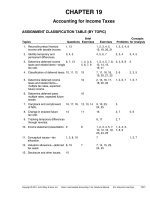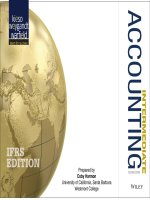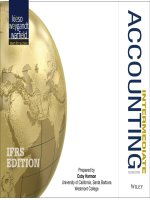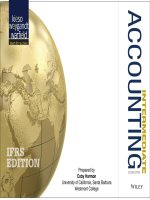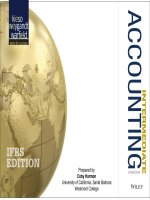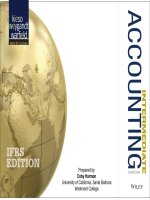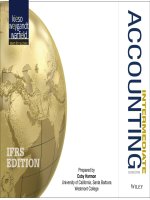Lecture Intermediate accounting (IFRS/e) - Chapter 19: Share-based compensation and earnings per share
Bạn đang xem bản rút gọn của tài liệu. Xem và tải ngay bản đầy đủ của tài liệu tại đây (1.52 MB, 46 trang )
Chapter 19
SHARE-BASED
COMPENSATION AND
EARNINGS PER SHARE
© 2013 The McGraw-Hill Companies, Inc.
Share-Based Compensation
Share Award Plans
Compensation:
• Salary
• Share awards
Restricted share plans
• Usually tied to continuing employment,
• Compensation is market price at date of grant,
• Compensation expense accrued over service period.
19 - 2
Share Option Plans
Share option plans give employees the option
to buy
(a) a specified number of shares of the firm's
share,
(b) at a specified exercise price,
(c) during a specified period of time.
The fair value is accrued as compensation
expense over the service period for which
participants receive the options, usually from
the date of grant to when the options become
exercisable (the vesting date).
19 - 3
Expense – The Great Debate
Historically, options have been measured
at their intrinsic value – the simple
difference between the market price of the
shares and the option price at which they
can be acquired. If the market and exercise
price are equal on the date of grant, no
compensation expense is recognized even
if the options provide executives with
substantial income.
19 - 4
Current Requirements
Things
Things changed
changed in
in November
November 2002
2002 when
when the
the IASB
IASB issued
issued
its
its exposure
exposure draft
draft ED
ED 22 on
on Share-based
Share-based Payment
Payment .. (This
(This
was
was followed
followed by
by the
the standard
standard IFRS
IFRS No.
No. 22 in
in February
February
2004.)
2004.)
The
The release
release of
of ED
ED 22 came
came in
in the
the aftermath
aftermath of
of the
the
accounting
accounting scandals
scandals and
and the
the “dot-com”
“dot-com” crisis,
crisis, and
and the
the
shell-shocked
shell-shocked market
market were
were more
more willing
willing to
to accept
accept aa
higher
higher level
level of
of discipline
discipline with
with regards
regards to
to disclosures
disclosures on
on
management
management compensation.
compensation.
Thus
Thus the
the requirement
requirement for
for companies
companies to
to measure
measure options
options
at
at their
their fair
fair values
values at
at the
the time
time they
they are
are granted
granted and
and to
to
expense
expense that
that amount
amount over
over the
the appropriate
appropriate service
service period
period
became
became required
required under
under both
both IFRS
IFRS and
and U.S.
U.S. GAAP
GAAP
19 - 5
Measurement Objectives
19 - 6
Recognizing Fair Value of Options
Accounting
Accounting for
for share
share options
options parallels
parallels the
the accounting
accounting
for
for restricted
restricted share
share we
we discussed
discussed earlier.
earlier. We
We now
now are
are
required
required to
to estimate
estimate the
the fair
fair value
value of
of share
share option
option
on
on the
the grant
grant date.
date.
IFRS (and U.S. GAAP) requires that
compensation expense be measured using one of
several option pricing models that deal with:
1. Exercise price of the option.
2. Expected term of the option.
3. Current market price of the share.
4. Expected dividends.
5. Expected risk-free rate of return.
6. Expected volatility of the share.
19 - 7
Plans with Performance or Market
Conditions
If compensation from a share option depends on meeting
a performance target, then whether we record
compensation depends.
• Initially on the best available estimate of the expected
number of options that will vest (i.e. based on the
company’s assessment of the likelihood of the
performance target being met) and
• Ultimately on whether the performance target actually is
met.
If the target is based on changes in the market rather
than on performance, we record compensation as if there
were no target.
19 - 8
U. S. GAAP vs. IFRS
There are more similarities than differences in the
treatment of share options. One major difference is the
treatment of deferred tax assets and when options have
graded-vesting.
•
19 - 9
A deferred tax asset (DTA) is
created for the cumulative
amount of the fair value of the
options the company has
recorded for compensation
expense.
• Account for each vesting
amount separately or account
for the entire award on the
straight-line basis over the
entire vesting period.
•
•
The deferred tax asset is not
created until the award is “in
the money;” that is it has
intrinsic value.
Straight-line choice is not
permitted. Companies not
required to recognize the
award that has vested by each
reporting date.
Plans With Graded-Vesting
Rather than share option plans vesting on a single date, more plans
awards specify that recipients gradually become eligible to exercise their
options rather than all at once. This is called “graded vesting.”
The company should view each vesting group
separately, as if it were a separate award.
For example, a company may award share options
that vest 25% in the first year, 25% in second year,
and 50% the third years. For accounting purposes
we have three separate awards.
The straightline method
is not
allowed
19 - 10
Employee share option plans
Permit employees to buy shares directly from
their employer.
Usually the plan is considered compensatory,
and compensation expense is recorded.
As long as ..
1. A company grants all holders of a particular class the right to
buy equity instruments at a discount and
2. An employee happens to be an investor in that particular class
and transacts with the company as an investor
The option plan it is simply record as a sale of new
shares to employees:
19 - 11
Employee share option plans
However, If the discounted sale is meant to benefit
only employees and is not extended to all investors in a
particular class, accounting is similar to other sharebased plans.
The discount to employees, then, is considered to be
compensation, and that amount is recorded as
expense.
The company measures the difference between the fair
value of shares issued and the cash received as the
compensation expense
Cash (100 × $8.50)
Compensation expense (100 × $1.50)
Ordinary shares (100 × $10.00)
Market
Market value
value
19 - 12
850
150
1,000
Earnings Per Share (EPS)
Of the myriad facts and figures
generated by accountants, the single
accounting number that is reported most
frequently in the media and receives by
far the most attention by investors and
creditors is earnings per share.
19 - 13
Basic Earnings Per Share
Simple Capital Structure
(Basic EPS)
Net
Net income
income (after
(after tax)
tax) –– preference
preference dividends*
dividends*
Weighted
Weighted average
average outstanding
outstanding ordinary
ordinary share
share
Number of shares outstanding
× Number of months outstanding ÷ 12
Weighted average shares outstanding
*Current
*Current period’s
period’s cumulative
cumulative preference
preference bonus
bonus issues
issues (whether
(whether or
or not
not
declared)
declared) and
and noncumulative
noncumulative preference
preference bonus
bonus issues
issues (only
(only ifif declared).
declared).
19 - 14
Issuance of New Shares
Compute the weighted average number of
shares of ordinary share outstanding.
Date
1/1
4/1
10/1
19 - 15
Description
Balance
Issued
Issued
No. of Shares
100,000
50,000
10,000
Issuance of New Shares
Compute the weighted average number of
shares of ordinary share outstanding.
Annual
Weighting
Annual
Weighting
100,000 + [50,000 × (9/12)] + [10,000 × (3/12)] = 140,000
Shares
at Jan. 1
19 - 16
New
Shares
New
Shares
Bonus Issues and Share Splits
Ordinary shares issued as part of bonus
issues (also known as share or stock
dividends) and share splits are treated
retroactively as subdivisions of the
shares already outstanding at the date
of the split or dividend.
19 - 17
Bonus Issues and Share Splits
Compute the weighted average number of shares
of ordinary share outstanding.
Date
1/1
4/1
5/1
19 - 18
Description
No. of Shares
Balance
100,000
Issued
50,000
Stock dividend(100%)
150,000
Bonus Issues and Share Splits
Compute the weighted-average number of
shares of ordinary share outstanding.
Annual
Weighting
100,000 × (2.00) + [50,000 × (9/12) × 2.00] = 275,000
Shares
at Jan. 1
New
Shares
bonus issue
adjustment
19 - 19
Bonus Issues and Share Splits
Retroactive treatment:
Yes
New
New shares
shares
issued
issued this
this period?
period?
Bonus
Bonus issue
issue or
or split
split is
is
applied
applied retroactively
retroactively in
in
proportion
proportion to
to the
the number
number of
of
shares
shares outstanding
outstanding at
at the
the
time
time of
of the
the dividend
dividend or
or split.
split.
19 - 20
No
Bonus
Bonus issue
issue or
or split
split is
is
treated
treated as
as outstanding
outstanding
from
from the
the beginning
beginning of
of
the
the period.
period.
Share Buy-Back
IfIf shares
shares were
were reacquired
reacquired during
during the
the
period,
period, the
the weighted-average
weighted-average number
number of
of
shares
shares is
is reduced.
reduced. The
The number
number of
of
reacquired
reacquired shares
shares is
is time-weighted
time-weighted for
for
the
the fraction
fraction of
of the
the year
year they
they were
were not
not
outstanding
outstanding..
19 - 21
Share Buy-Back
Compute the weighted-average number of
shares of ordinary share outstanding.
Date
1/1
4/1
5/1
19 - 22
Description
Balance
Issued
Repurchased shares
No. of Shares
100,000
50,000
12,000
Share Buy-Back
Compute the weighted-average number of
shares of ordinary share outstanding.
Annual
Weighting
Annual
Weighting
100,000 + [50,000 × (9/12)] - [12,000 × (8/12)] = 129,500
Shares
at Jan. 1
19 - 23
New
Shares
Treasury
Shares
Earnings Available to
Ordinary Shareholders
Net income
Less: Current period’s cumulative preference share*
dividends (whether or not declared)
Less: Noncumulative preference share* dividends (only if
declared)
Net income available to ordinary shareholders
*Or more senior classes of shareholders
19 - 24
Diluted Earnings Per Share
Potential
Ordinary Shares:
Shares:
Potential Ordinary
• Share
Share options
options and
and warrants
warrants
• Convertible
Convertible bonds
bonds and
and share
share
• Contingent
ordinary share
share
Contingent ordinary
issues
issues
Contingently
issuable
shares
Complex Capital Structure
(Dual EPS)
Share
Options
Convertible
securities
Treasury share
method
If-converted
method
Dilution/Antidilution Test
May Report Basic and Diluted Earnings Per Share
19 - 25


